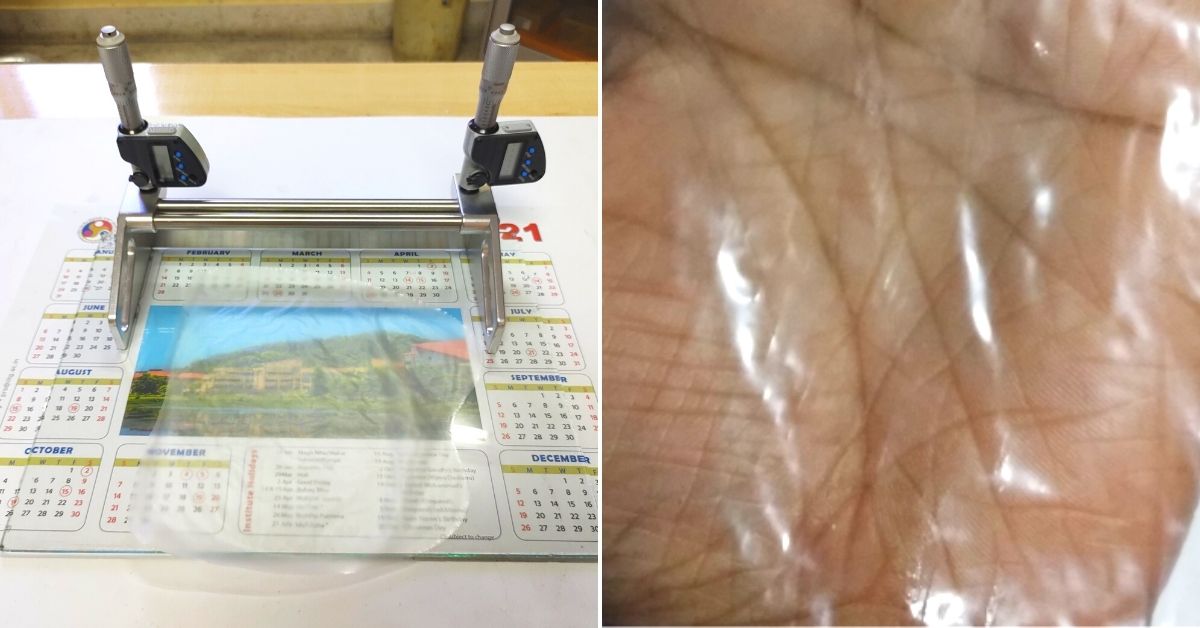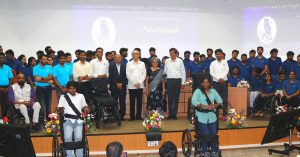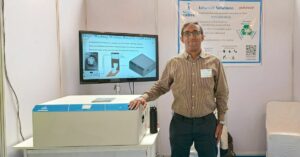IIT-G Invents Biodegradable Bandages That Are Half The Price of Regular Ones
IIT-Guwahati researchers have invented a biodegradable, low-cost Composite Transparent Wound Dressing Film. The polymer-based hydrogel films have several key advantages.

Researchers from the Department of Chemical Engineering at the Indian Institute of Technology-Guwahati (IIT-G) have recently invented something which could shake up the global medical device industry. In a press release issued on 9 August, the institute claimed that their team of four researchers have invented what they call a ‘Composite Transparent Wound Dressing Film’. They claim this material could change the way hospitals bandage wounds in a safer, more natural and eco-friendly way than using cotton wool, lint and gauzes.
(Image above of Aritra Das, PhD Scholar, Professor Chandan Das & , Professor Ramagopal V.S. Uppaluri at IIT-G)
Based on the integration of a synthetic polymer, this material is non-toxic and “will create a moist environment that would enable the body to heal on its own through the endogenous enzymes,” according to their release. Their findings were recently published in a global peer-reviewed journal called the International Journal of Biological Macromolecules.
What’s more, this laboratory-scale development was found to be 50 per cent cheaper than similar materials made commercially.
“This invention has the potential to make a huge impact on the field. It emphasises upon the integration of a synthetic polymer, namely polyvinyl alcohol (PVA), with a natural polymer starch (St) to eventually achieve a low-cost, biodegradable, non-toxic and transparent composite hydrogel,” says Aritra Das, PhD scholar and First Author (who contributed most to the work).
Assisting her in this research endeavour were Srirupa Bhattacharyya, Doctoral Fellow and faculty members Prof Chandan Das and Prof Ramagopal VS Uppaluri from IIT-G.
On the composition of this wound dressing film, Prof Chandan further explains, “In the biodegradable low-cost composite transparent wound dressing film, polyvinyl alcohol (PVA as synthetic polymer) and starch (St as natural polymer) have been used as base polymers. Thereby, the polymeric network has been further modified with organic additives such as glycerol (Gl) and citric acid (CA) that functionally serve as cross linker, plasticizers and antibacterial agents in due course of the film performance. Further, in due course of research tenure, citric acid was replaced with organic acid in the optimised ternary formulation (PVA-St-Gl composite). So doing, malic acid (MA) is another appropriate option to serve as a compatible acid for the targeted wound dressing application of the polymer composite film.”
He goes on to add, “The film has been prepared using a solution casting method which is a highly inexpensive fabrication method and can be adopted even in circumstances that can’t afford large scale processing schemes. Further details of the fabrication procedures are available in the published article in International Journal of Biological Macromolecules.”
Less Pain, Natural Healing
While cotton wool, gauzes and lint are commonly used to dress up wounds because of their ability to manage wound exudates and speed up the healing process, they come with their own disadvantages.
Anyone who has ever suffered a serious wound would know the pain involved in removing such material to either replace it with a fresh one or get rid of it entirely. Moreover, if not done carefully, the removal process can even damage a healed tissue. Another concern is that such materials are opaque. Nurses must regularly remove them for sensitive wounds to closely monitor and visualise how they’re healing and what treatment procedures are required.
Besides its ability to prevent wound exudate accumulation on the surface, which may lead to the maceration of the newly generated tissue, the polymer-based hydrogel films developed by researchers at IIT-G have several key advantages.
They are transparent, which allows for wound observation without changing the dressing materials. Further, the transparent film can be easily taken off without causing pain or damaging healed tissue because of the controlled moist environment facilitated by the material. Researchers also found that the material is biocompatible, preventing any kind of toxicity that challenges or hampers the growth of cells, tissues and natural healing processes.
“You can apply and place the film over the wound. The film structure with adequate mechanical strength and elongation characteristics facilitates the product to take any shape or curvature. The same can be realised over the wound due to its transparency, which is a very important feature of the film. After coming in contact with the wound exudate fluids, the composite film would get swollen and softened. Thereby, the surface achieves a gel-like structure and thereby leeches its constituents to reach the surface and facilitate a localised antibacterial effect. The softened and moist environment of the developed product would thereby assist in the wound healing on its own. Further, the protection barrier ensured through the leached constituents accelerate the cellular and tissue growth in the wound region,” says Prof Das
In other words, the developed product is anticipated to significantly accelerate the wound healing process in comparison with conventional wound dressing materials such as bandages. It is well known that every wound requires a characteristic time frame of healing and is dependent upon the nature of the wound. Based on the weight loss characteristics being evaluated for the composite, the wear time of the product has been estimated to be 3-7 days and is so due to the wound depth and oozing of the wound fluid.
Of course, further tests are needed to ascertain a more accurate figure.

A Cheaper & Biodegradable Option
Prof Das goes on to claim that the polymer-based hydrogel films are biodegradable and cheaper than their commercial counterparts. “The laboratory scale-based retail cost of the optimised CA-based PVA-St composite hydrogel film has been about Rs. 0.188/cm2. This is about 66% inexpensive in comparison with similar commercial materials such as 3M Tegaderm IV Transparent Film (1633IN) that costs Rs 0.565 /cm2. Compared to the reported CA-based PVA-St composite hydrogel film, the recently invented MA-based similar film has been about 4.56% inexpensive. Therefore, considering processing costs and probable insights from scale up studies, the anticipated price of the developed materials is expected to be about 50 per cent of the commercial price of the mentioned materials,” he says.
Elaborating on where their research stands and how it can be applied on the field, Prof Ramagopal Uppaluri, says, “The research has been carried out in an experimental and table top research environment that needs furthering studies towards scale up as well as in-vivo analysis (real world applications). Among these, the scale up-related studies can be addressed after targeting the in-vivo analysis using specimens such as wounded rats.
Meanwhile, Prof Das goes on to add, “Our research group at IIT-G attempted and has been successful to identify an optimal and low-cost biodegradable composite film compatible for wound dressing applications. To date, no private players have approached all of us. However, there are plans for any private players that are interested to fund the product development on a commercial scale. Therefore, all of us are eager to collaborate with any firm that may be interested.”
(Edited by Yoshita Rao)
Like this story? Or have something to share? Write to us: [email protected], or connect with us on Facebook and Twitter.
This story made me
- 97
- 121
- 89
- 167
Tell Us More
We bring stories straight from the heart of India, to inspire millions and create a wave of impact. Our positive movement is growing bigger everyday, and we would love for you to join it.
Please contribute whatever you can, every little penny helps our team in bringing you more stories that support dreams and spread hope.



















